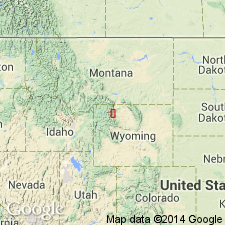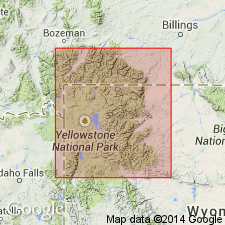
- Usage in publication:
-
- Jim Mountain Member*
- Modifications:
-
- Named
- Dominant lithology:
-
- Trachyandesite
- AAPG geologic province:
-
- Bighorn basin
Summary:
Named as a member that occurs near the middle of the Wapiti Formation for exposures in vicinity of Jim Mountain which are designated the type area, Park Co, WY in Bighorn basin. Consists of eight to 10 trachyandesite flows about 1,000 ft thick. Thins southward so that in area between North and South Forks of Shoshone River only one flow is present. Overlies and underlies unnamed parts of Wapiti. Assigned an early or middle Eocene age, or both.
Source: GNU records (USGS DDS-6; Denver GNULEX).

- Usage in publication:
-
- Jim Mountain Member*
- Modifications:
-
- Revised
- AAPG geologic province:
-
- Yellowstone province
Summary:
Assigned as a member of Wapiti Formation to Sunlight Group (new) of Absaroka Volcanic Supergroup (new). Thins to southeast from its type section. Westward it grades into vent facies of Wapiti. Thought to be of early middle Eocene age.
Source: GNU records (USGS DDS-6; Denver GNULEX).
For more information, please contact Nancy Stamm, Geologic Names Committee Secretary.
Asterisk (*) indicates published by U.S. Geological Survey authors.
"No current usage" (†) implies that a name has been abandoned or has fallen into disuse. Former usage and, if known, replacement name given in parentheses ( ).
Slash (/) indicates name conflicts with nomenclatural guidelines (CSN, 1933; ACSN, 1961, 1970; NACSN, 1983, 2005, 2021). May be explained within brackets ([ ]).

